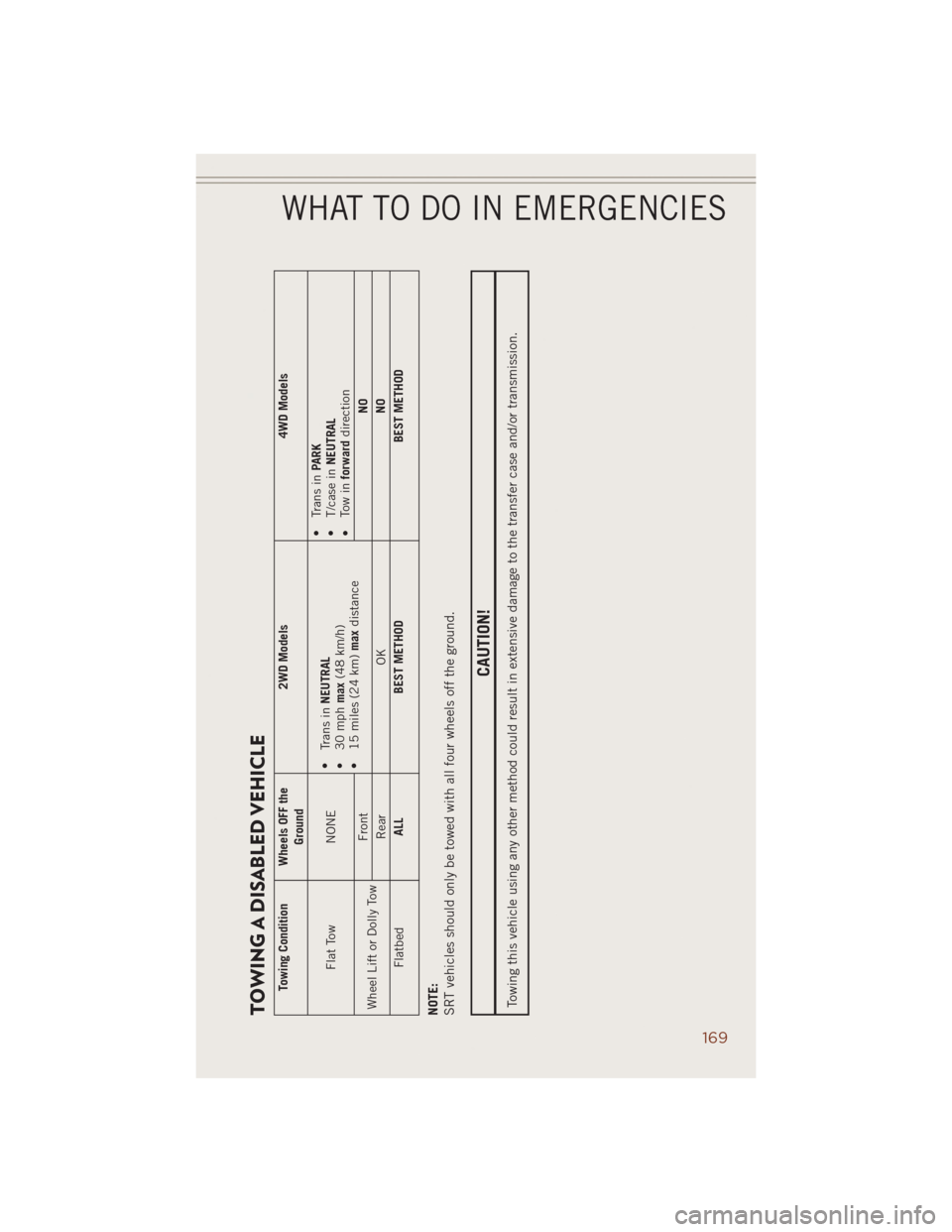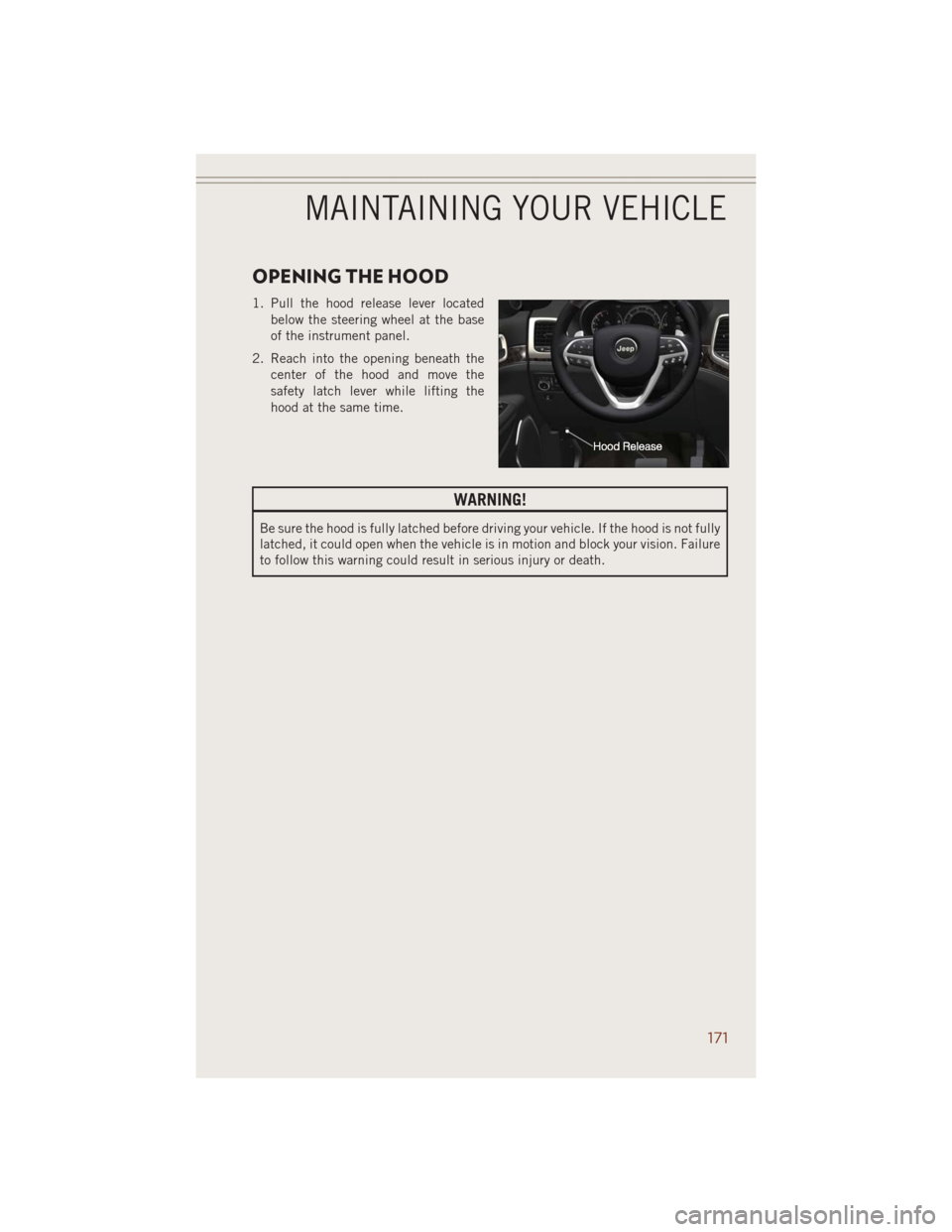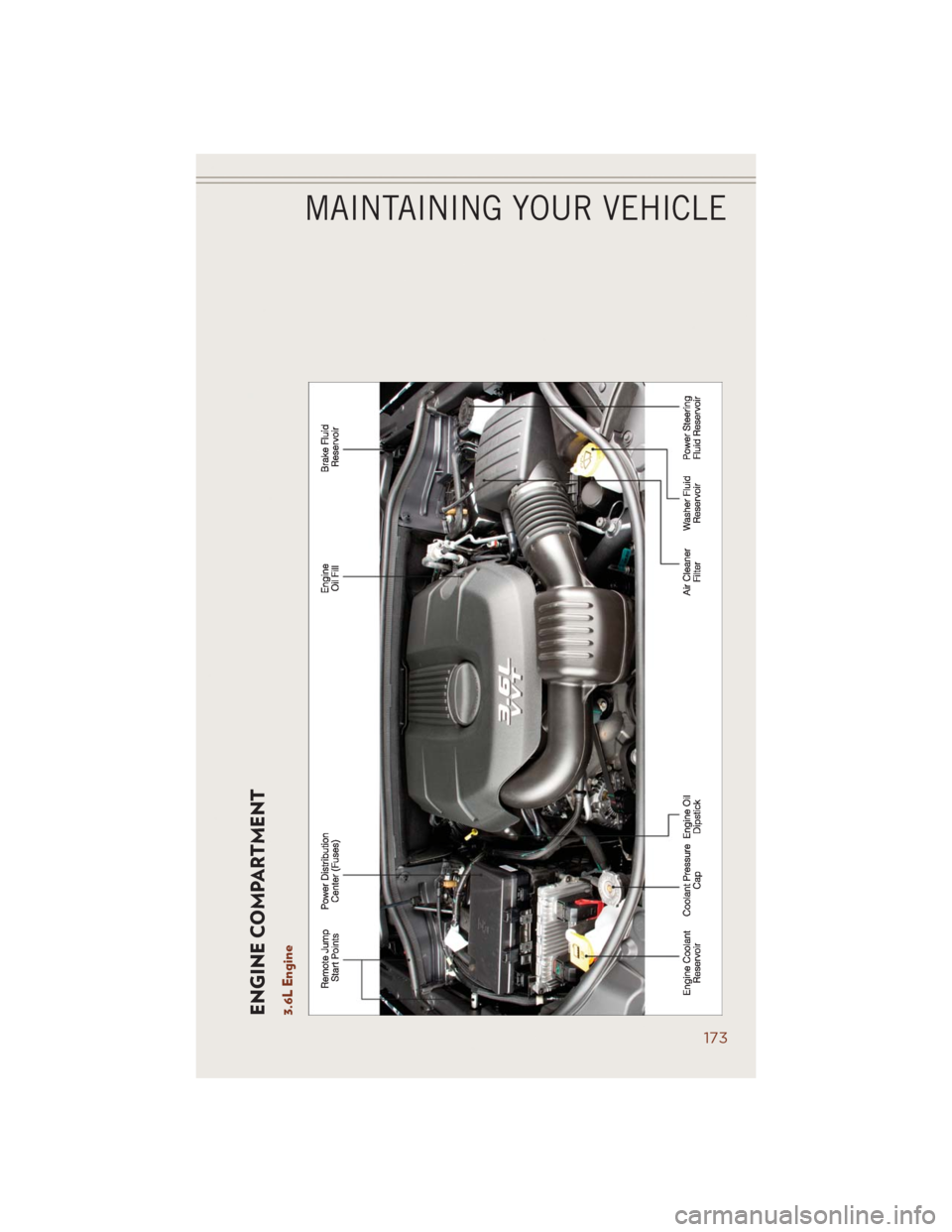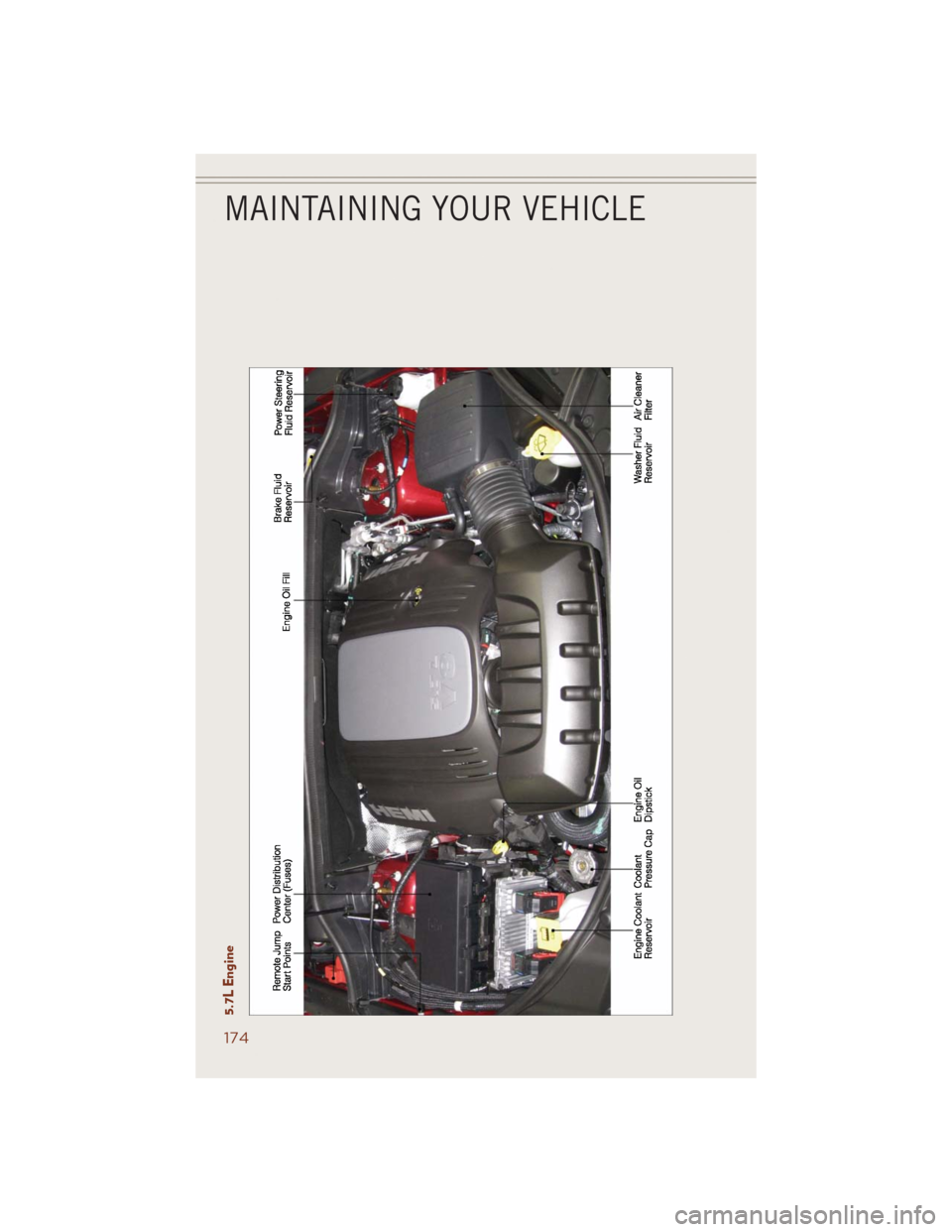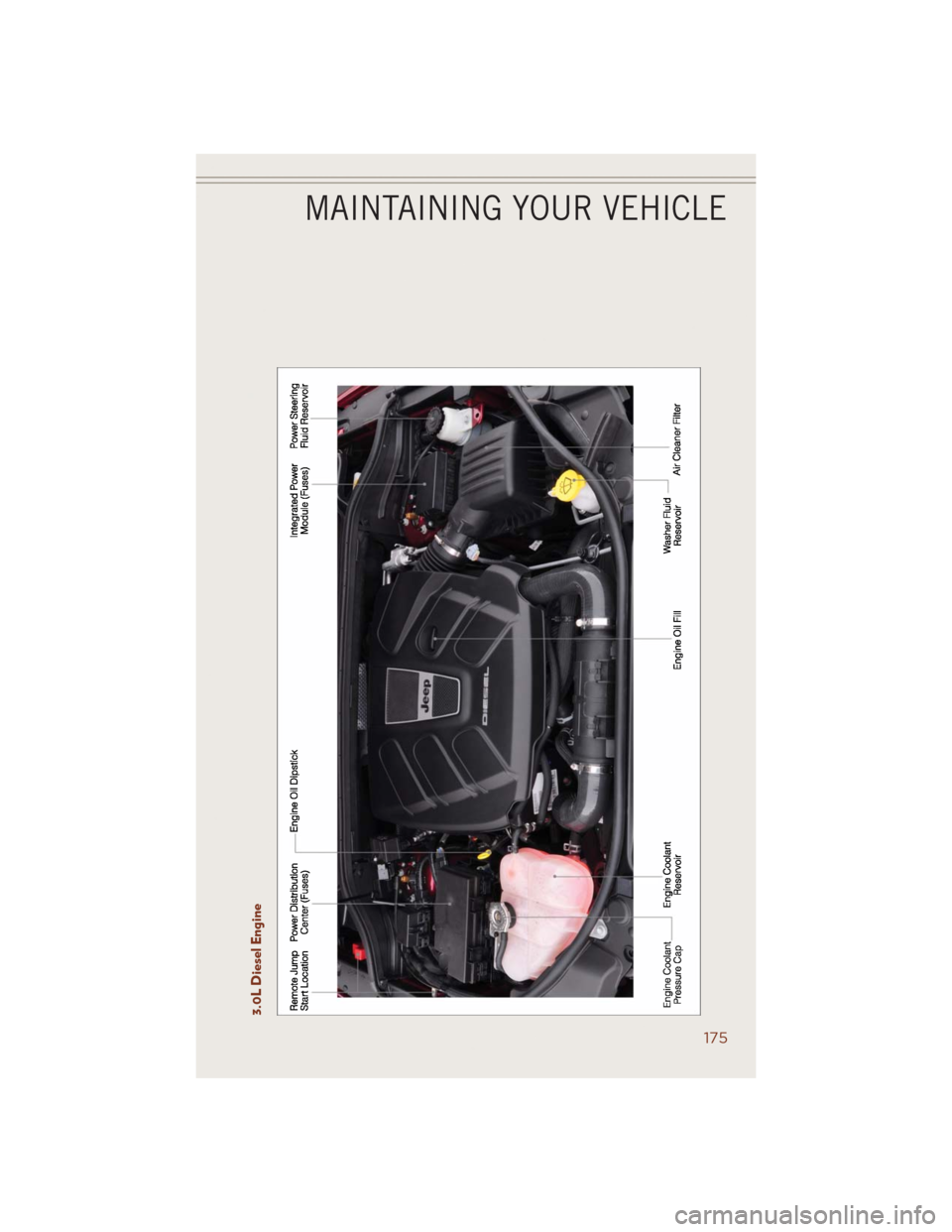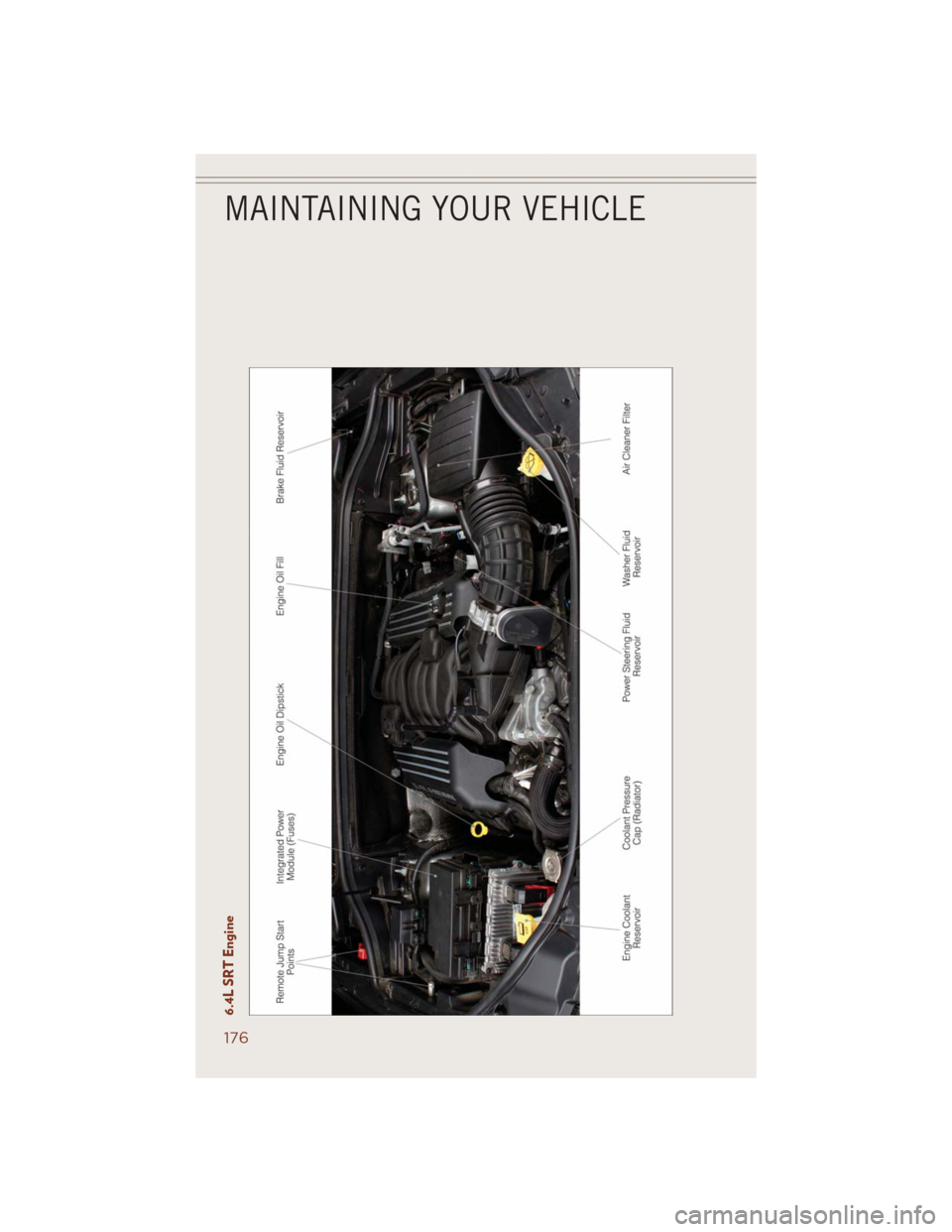JEEP GRAND CHEROKEE 2014 WK2 / 4.G User Guide
GRAND CHEROKEE 2014 WK2 / 4.G
JEEP
JEEP
https://www.carmanualsonline.info/img/16/7107/w960_7107-0.png
JEEP GRAND CHEROKEE 2014 WK2 / 4.G User Guide
Trending: octane, ad blue, wheel size, coolant level, automatic transmission fluid, spark plugs, catalytic converter
Page 171 of 220
TOWING A DISABLED VEHICLE
Towing Condition Wheels OFF the
Ground2WD Models 4WD Models
Flat Tow NONE•
Trans inNEUTRAL
• 30 mphmax(48 km/h)
• 15 miles (24 km)maxdistance•
Trans inPARK
• T/case inNEUTRAL
• Tow inforwarddirection
Wheel Lift or Dolly TowFrontNO
Rear OKNO
FlatbedALL BEST METHOD BEST METHOD
NOTE:
SRT vehicles should only be towed with all four wheels off the ground.
CAUTION!
Towing this vehicle using any other method could result in extensive damage to the transfer case and/or transmission.
WHAT TO DO IN EMERGENCIES
169
Page 172 of 220
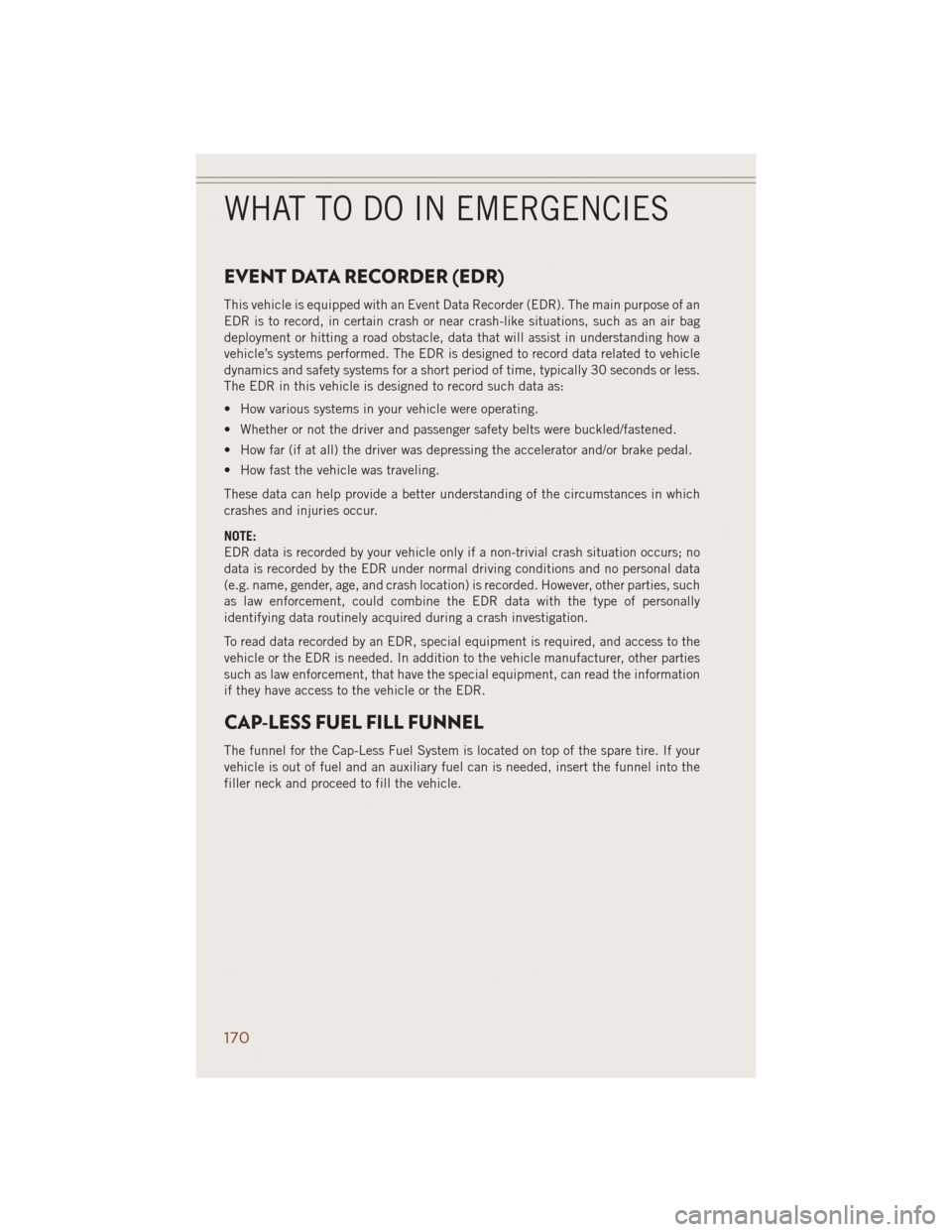
EVENT DATA RECORDER (EDR)
This vehicle is equipped with an Event Data Recorder (EDR). The main purpose of an
EDR is to record, in certain crash or near crash-like situations, such as an air bag
deployment or hitting a road obstacle, data that will assist in understanding how a
vehicle’s systems performed. The EDR is designed to record data related to vehicle
dynamics and safety systems for a short period of time, typically 30 seconds or less.
The EDR in this vehicle is designed to record such data as:
• How various systems in your vehicle were operating.
• Whether or not the driver and passenger safety belts were buckled/fastened.
• How far (if at all) the driver was depressing the accelerator and/or brake pedal.
• How fast the vehicle was traveling.
These data can help provide a better understanding of the circumstances in which
crashes and injuries occur.
NOTE:
EDR data is recorded by your vehicle only if a non-trivial crash situation occurs; no
data is recorded by the EDR under normal driving conditions and no personal data
(e.g. name, gender, age, and crash location) is recorded. However, other parties, such
as law enforcement, could combine the EDR data with the type of personally
identifying data routinely acquired during a crash investigation.
To read data recorded by an EDR, special equipment is required, and access to the
vehicle or the EDR is needed. In addition to the vehicle manufacturer, other parties
such as law enforcement, that have the special equipment, can read the information
if they have access to the vehicle or the EDR.
CAP-LESS FUEL FILL FUNNEL
The funnel for the Cap-Less Fuel System is located on top of the spare tire. If your
vehicle is out of fuel and an auxiliary fuel can is needed, insert the funnel into the
filler neck and proceed to fill the vehicle.
WHAT TO DO IN EMERGENCIES
170
Page 173 of 220
OPENING THE HOOD
1. Pull the hood release lever located
below the steering wheel at the base
of the instrument panel.
2. Reach into the opening beneath the
center of the hood and move the
safety latch lever while lifting the
hood at the same time.
WARNING!
Be sure the hood is fully latched before driving your vehicle. If the hood is not fully
latched, it could open when the vehicle is in motion and block your vision. Failure
to follow this warning could result in serious injury or death.
MAINTAINING YOUR VEHICLE
171
Page 174 of 220
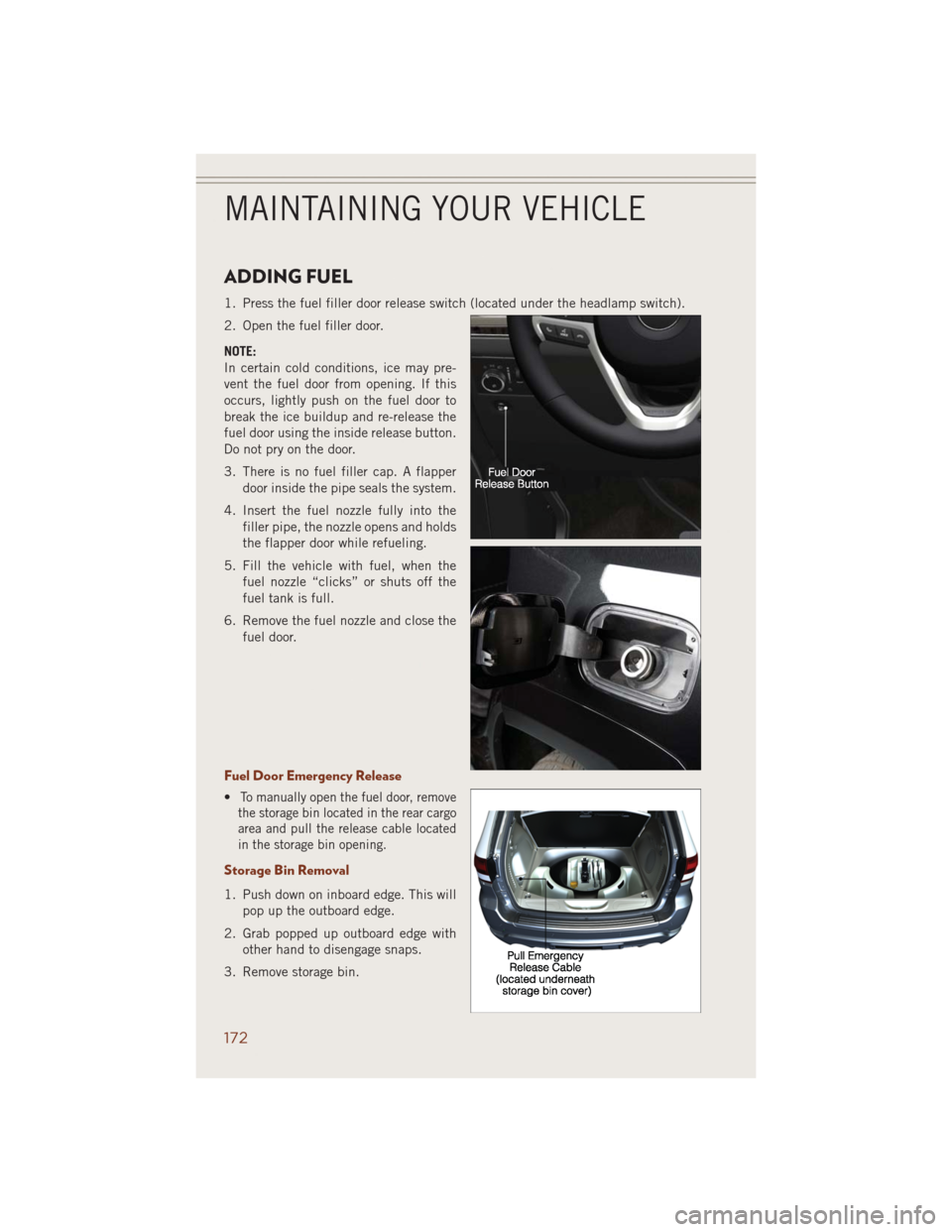
ADDING FUEL
1. Press the fuel filler door release switch (located under the headlamp switch).
2. Open the fuel filler door.
NOTE:
In certain cold conditions, ice may pre-
vent the fuel door from opening. If this
occurs, lightly push on the fuel door to
break the ice buildup and re-release the
fuel door using the inside release button.
Do not pry on the door.
3. There is no fuel filler cap. A flapper
door inside the pipe seals the system.
4. Insert the fuel nozzle fully into the
filler pipe, the nozzle opens and holds
the flapper door while refueling.
5. Fill the vehicle with fuel, when the
fuel nozzle “clicks” or shuts off the
fuel tank is full.
6. Remove the fuel nozzle and close the
fuel door.
Fuel Door Emergency Release
•To manually open the fuel door, remove
the storage bin located in the rear cargo
area and pull the release cable located
in the storage bin opening.
Storage Bin Removal
1. Push down on inboard edge. This will
pop up the outboard edge.
2. Grab popped up outboard edge with
other hand to disengage snaps.
3. Remove storage bin.
MAINTAINING YOUR VEHICLE
172
Page 175 of 220
ENGINE COMPARTMENT3.6L Engine
MAINTAINING YOUR VEHICLE
173
Page 176 of 220
5.7L Engine
MAINTAINING YOUR VEHICLE
174
Page 177 of 220
3.0L Diesel Engine
MAINTAINING YOUR VEHICLE
175
Page 178 of 220
6.4L SRT Engine
MAINTAINING YOUR VEHICLE
176
Page 179 of 220
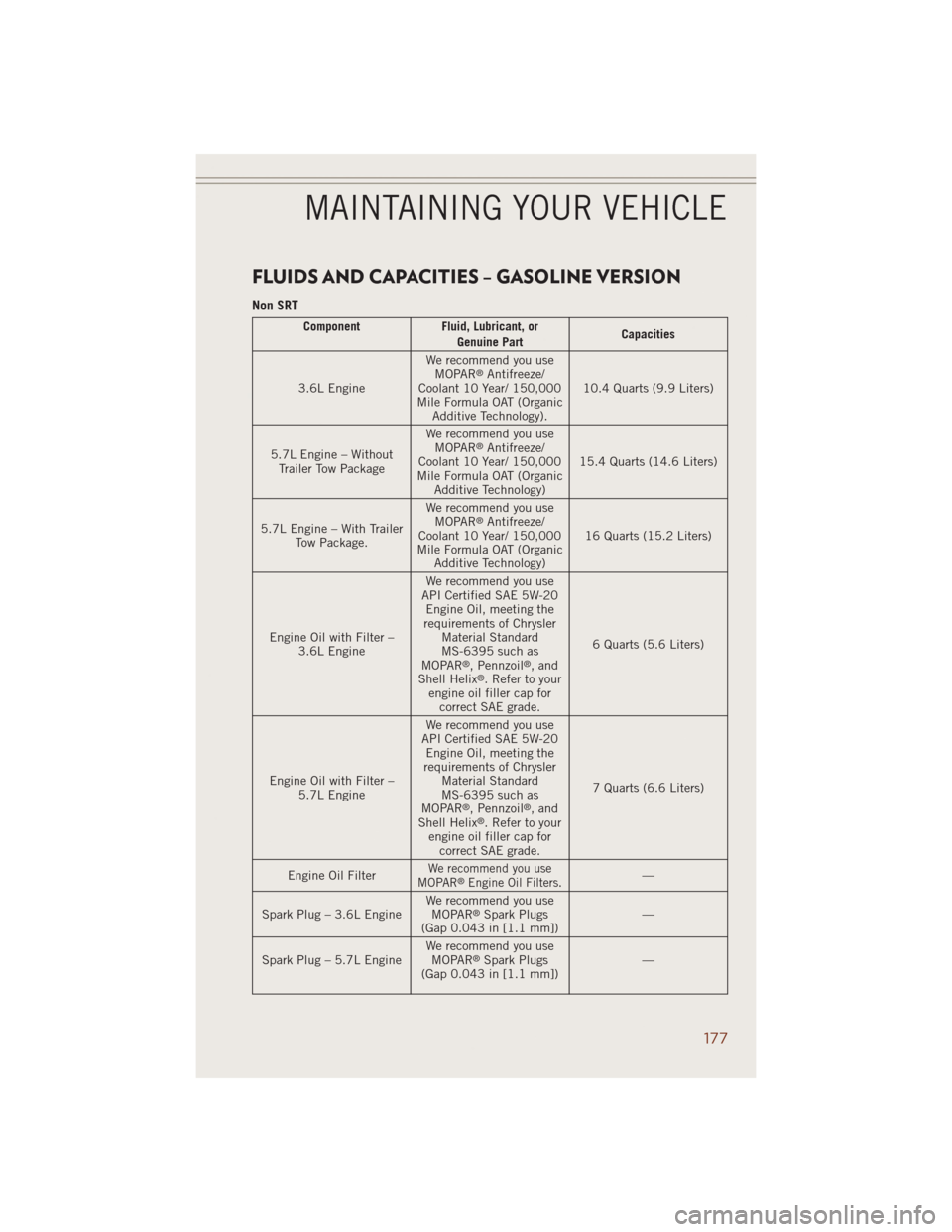
FLUIDS AND CAPACITIES – GASOLINE VERSION
Non SRT
Component Fluid, Lubricant, or
Genuine PartCapacities
3.6L EngineWe recommend you use
MOPAR
®Antifreeze/
Coolant 10 Year/ 150,000
Mile Formula OAT (Organic
Additive Technology).10.4 Quarts (9.9 Liters)
5.7L Engine – Without
Trailer Tow PackageWe recommend you use
MOPAR
®Antifreeze/
Coolant 10 Year/ 150,000
Mile Formula OAT (Organic
Additive Technology)15.4 Quarts (14.6 Liters)
5.7L Engine – With Trailer
Tow Package.We recommend you use
MOPAR
®Antifreeze/
Coolant 10 Year/ 150,000
Mile Formula OAT (Organic
Additive Technology)16 Quarts (15.2 Liters)
Engine Oil with Filter –
3.6L EngineWe recommend you use
API Certified SAE 5W-20
Engine Oil, meeting the
requirements of Chrysler
Material Standard
MS-6395 such as
MOPAR
®, Pennzoil®,and
Shell Helix®. Refer to your
engine oil filler cap for
correct SAE grade.6 Quarts (5.6 Liters)
Engine Oil with Filter –
5.7L EngineWe recommend you use
API Certified SAE 5W-20
Engine Oil, meeting the
requirements of Chrysler
Material Standard
MS-6395 such as
MOPAR
®, Pennzoil®,and
Shell Helix®. Refer to your
engine oil filler cap for
correct SAE grade.7 Quarts (6.6 Liters)
Engine Oil Filter
We recommend you use
MOPAR®Engine Oil Filters.—
Spark Plug – 3.6L EngineWe recommend you use
MOPAR
®Spark Plugs
(Gap 0.043 in [1.1 mm])—
Spark Plug – 5.7L EngineWe recommend you use
MOPAR
®Spark Plugs
(Gap 0.043 in [1.1 mm])—
MAINTAINING YOUR VEHICLE
177
Page 180 of 220
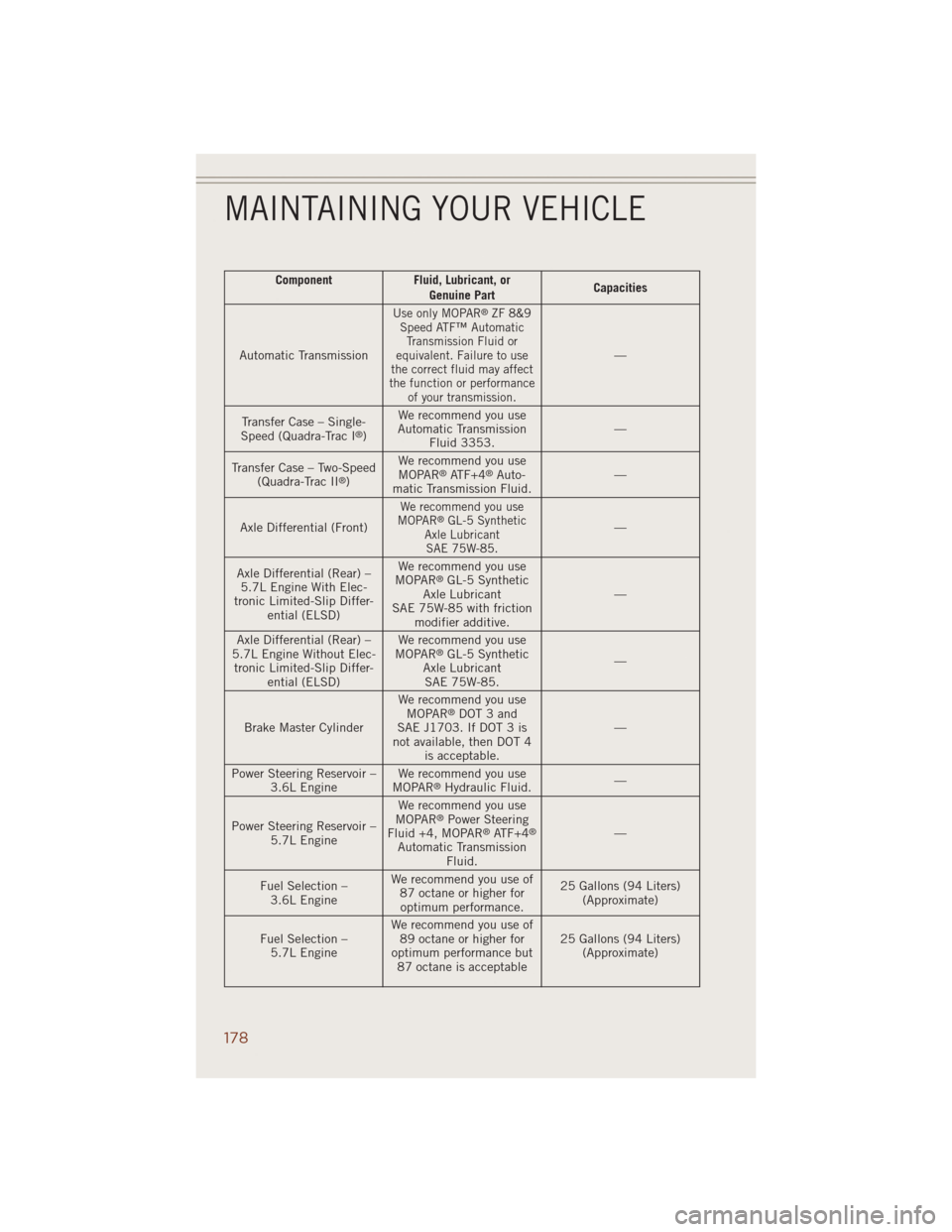
Component Fluid, Lubricant, or
Genuine PartCapacities
Automatic Transmission
Use only MOPAR®ZF 8&9
Speed ATF™ Automatic
Transmission Fluid or
equivalent. Failure to use
the correct fluid may affect
the function or performance
of your transmission.
—
Transfer Case – Single-
Speed (Quadra-Trac I
®)We recommend you use
Automatic Transmission
Fluid 3353.—
Transfer Case – Two-Speed
(Quadra-Trac II
®)We recommend you use
MOPAR®ATF+4®Auto-
matic Transmission Fluid.—
Axle Differential (Front)
We recommend you use
MOPAR®GL-5 Synthetic
Axle Lubricant
SAE 75W-85.—
Axle Differential (Rear) –
5.7L Engine With Elec-
tronic Limited-Slip Differ-
ential (ELSD)We recommend you use
MOPAR
®GL-5 Synthetic
Axle Lubricant
SAE 75W-85 with friction
modifier additive.—
Axle Differential (Rear) –
5.7L Engine Without Elec-
tronic Limited-Slip Differ-
ential (ELSD)We recommend you use
MOPAR
®GL-5 Synthetic
Axle Lubricant
SAE 75W-85.—
Brake Master CylinderWe recommend you use
MOPAR
®DOT 3 and
SAE J1703. If DOT 3 is
not available, then DOT 4
is acceptable.—
Power Steering Reservoir –
3.6L EngineWe recommend you use
MOPAR
®Hydraulic Fluid.—
Power Steering Reservoir –
5.7L EngineWe recommend you use
MOPAR
®Power Steering
Fluid +4, MOPAR®ATF+4®
Automatic Transmission
Fluid.—
Fuel Selection –
3.6L EngineWe recommend you use of
87 octane or higher for
optimum performance.25 Gallons (94 Liters)
(Approximate)
Fuel Selection –
5.7L EngineWe recommend you use of
89 octane or higher for
optimum performance but
87 octane is acceptable25 Gallons (94 Liters)
(Approximate)
MAINTAINING YOUR VEHICLE
178
Trending: spare tire location, fuel fill door release, radiator, oil filter, fuel tank capacity, cruise control, suspension
